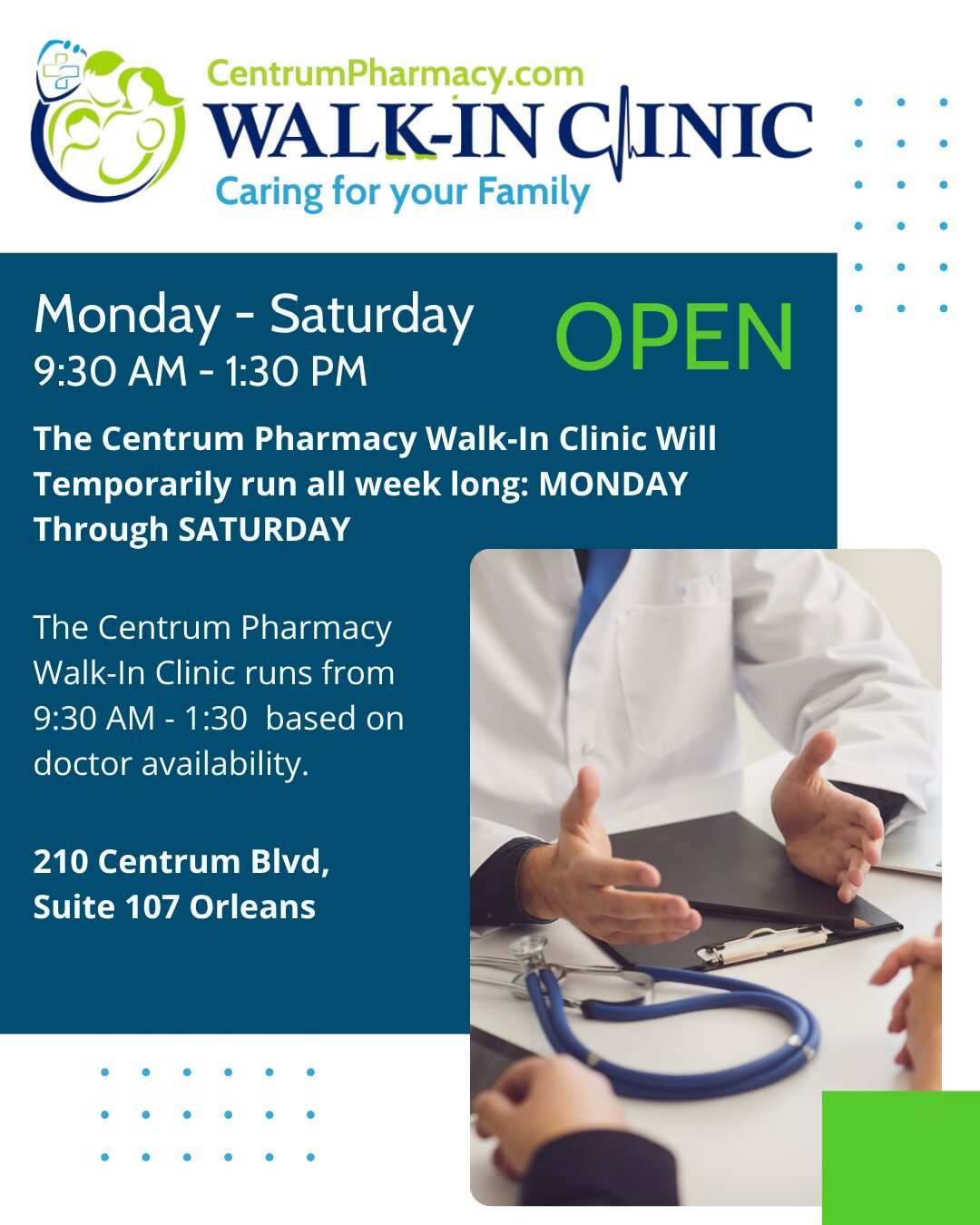Community pharmacy in Ontario is at a crossroads. For many pharmacy owners, the label “independent pharmacist” has become a misnomer: they carry the risks of the business—rent, staffing, regulatory compliance—but with little power over the professional-service fees or business model driving sustainability. Many pharmacists in Ontario effectively operate as “dependent contractors”, underscoring a systemic problem. (“They bear all the risks … but are denied the fundamental right to set or negotiate the prices for their own professional services and fees.”). The community pharmacy landscape in Ontario is facing a structural crisis. What many would consider “independent pharmacies” are increasingly operating under the economics of a dependent contractor model and are dominated by a few large payers and chains.
At Centrum Pharmacy, we recognise this reality, and we’re working hard to navigate this system and chart our own course: one that anchors pharmacy in accessible healthcare, clinical services, meaningful patient-relationships—and not simply product dispensing under unsustainable reimbursement. Below is a deeper dive into the economics, the risk of corporate consolidation, how our model is different— and why our patients stand to benefit
1. The economics of dependence & why the current model is unsustainable
1.1 Historical foundations of dependence
- Prior to 1996, the Ontario Drug Benefit Act mandated a formal negotiating committee for dispensing fees between the Ontario Pharmacists’ Association (OPA) and the Ministry of Health.
- In 1996, Bill 26 removed that negotiating forum, granting the government unilateral regulatory power over pharmacy fees.
- A key trade-off: many pharmacy owners accepted margins from product (including generic drug rebates) in lieu of a robust professional-fee base—but that trade‐off expired as the generic margin model was dismantled (e.g., Bill 102 in 2006, the Transparent Drug System for Patients Act).
- The result: pharmacy owners carry full operational risk, but for a large part of their revenue they cannot set or negotiate key fees – leaving many pharmacies highly exposed.
- Under labour law, the term “dependent contractor” describes someone economically dependent on a few payers for income but without the independence of an employer-employee. This truth mirrors many Ontario pharmacy owners: all entrepreneurial risk, limited pricing power, and heavy dependence on the ODB program + pharmacy benefit managers (PBMs).
In short: a business model heavily reliant on product dispensing with little recognition of the professional service component, and income largely set in the hands of payers rather than providers or business owners. The consequences: closure risk, staff burnout, reduced consultation time, and pressure on patient safety.
1.2 The impact of fixed/eroded dispensing fees
- For many ODB (Ontario Drug Benefit) claims the set dispensing fee (for many years) has been around $8.83—with inflation eroding its value by more than 25-30% over a decade.
- Rising costs for labour, regulatory compliance, technology, staffing, and professional training mean margin from dispensing is shrinking in real terms.
- According to the “Economic Footprint of Ontario’s Community Pharmacy Sector,” in 2016 the sector generated an estimated $708.5 million in fiscal benefits to government.
- Industry data show that Canada’s retail pharmacy market is about US $39.8 billion (~C$55-60 billion) in 2024, expected to grow to ~US $50.7 billion by 2032.
- Ontario alone contributes approximately 38% of the total Canadian retail pharmacy market revenue. Credence Research Inc.
- If the revenue base is fixed or slowly growing, but costs continue increasing, then pharmacy businesses must shift from volume toward value—yet the reimbursement model remains largely tied to product dispensing.
1.3 Unsustainable model & rising consolidation risk
- Independent pharmacies in Canada are operating under financial pressure. For example, in the U.S., nearly 1 in 3 retail pharmacies closed since 2010.
- In Canada, analysis shows that major chains and banners dominate. For example: in 2023, chain & banner drugstores accounted for 7,848 outlets, while independents numbered only 2,454.
- A research insight titled “Drugstores in Canada: In the Hands of a Few” found increasing concentration in the sector—fewer players controlling more of the market.
- Another academic piece (Pharmacy Deserts & Antitrust Law) states: “top three PBMs controlled 85% of the market… chain pharmacies owned PBMs… strong incentive to destroy independent pharmacies.”
- These trends suggest that the current model is not only unsustainable for independent pharmacies but may be structurally tilted in favour of large corporate chains that can use scale, vertical integration and loss-leader strategies to dominate and squeeze independents.
2. Corporate consolidation, loss leaders & market control
- Large national chains (e.g., Shoppers Drug Mart) and banners dominate the Canadian market: one source lists Shoppers at 1,189 locations as of 2025.
- When chains can absorb lower margins (because they gain scale, vertical supply chain control, in-house PBM integration) they are in a position to undercut independents.
- The independent pharmacist may face: limited negotiation power, retroactive claw-backs, lower reimbursement, patient-steering away from independent locations (in U.S. context at least) as chain-owned PBMs direct volume to affiliated sites.
- The net effect: independent pharmacies may be treated as “loss leaders” or at least strategically disadvantaged in pricing/reimbursement, while chains build dominance, reducing competition, limiting patient choice, and threatening local access—particularly in underserviced and rural communities.
- In Ontario, where rural access is already challenged (e.g., only 40.9% of rural residents live within 5 km of a pharmacist vs 99.4% in urban areas).
- The risk: closure of independent pharmacies diminishes diversity of provider models, reduces local tailoring of services, and increases vulnerability of communities to monopolistic dynamics.
3. Why this matters to patients, primary care access & for our community
- When independent pharmacies close or are forced to conform to high-volume, low-margin models, patient care suffers: less time for counselling, fewer clinical consultations, more transaction-based models.
- For patients without a family doctor — in Ontario over 2 million Ontarians lack a primary care physician — having accessible, full-service community pharmacies is a vital component of the healthcare ecosystem.
- Our model at Centrum Pharmacy, aligned with Orleans Family Health Clinic, helps bridge that gap by integrating pharmacist- and physician-led care, but that model depends on a sustainable business foundation.
- If independent pharmacies are squeezed out, the remaining chain-based model may prioritise product volume, cost-control and centralised workflows rather than local, connected, holistic patient care.
At Centrum Pharmacy our mission is “Connected. Comprehensive. Caring. Complete.” — the “4 C’s” of care. The systemic funding pressures in community pharmacy jeopardise each of these pillars:
- Connected: When pharmacy business pressures force high prescription volumes, minimal staffing and workflow demands, the opportunity for meaningful pharmacist-patient connection is diminished.
- Comprehensive: With product margins squeezed and dispensing revenue under pressure, investment in clinical services (medication reviews, chronic disease monitoring, patient counselling) becomes harder to justify or staff.
- Caring: Work environments under stress lead to employee burnout, compromised service quality, and turnover—all of which impact patient experience and outcomes.
- Complete: A pharmacy that is financially unstable, competing only on price or stock, cannot deliver the full spectrum of modern pharmacy care (immunizations, minor ailment prescribing, chronic care support, collaborative care with physicians).
Furthermore, as Ontario’s government has signalled ambitions to expand pharmacy scope (“Exploring more ways to expand role of pharmacists” in 2024) the contrast becomes stark: the system expects pharmacists to do more, yet the remuneration and business model remain anchored in product dispensing. This disjunction needs to be actively addressed.
4. Centrum Pharmacy’s proactive response: a sustainable, value-centred model
4.1 Physician Recruitment & Integration with Family Practice
- We actively recruit and integrate physicians and connect our patients with the Orleans Family Health Clinic. This means:
- Patients who come to us often get linked (“rostered”) with a family doctor via the clinic partner, reducing their wait for primary care and ensuring continuity.
- Pharmacists and physicians collaborate: medication management, chronic disease follow-up, preventative care and immunizations are all coordinated rather than fragmented.
This integration shifts us away from being another retail stop and places us firmly in the healthcare team. This integration eases the dependence on product margin and anchors our value in the professional services we provide.
4.2 Minor-Ailment Care Model & the 4 C’s (Complete, Comprehensive, Caring, Connected)
- Complete: every prescription pick-up is an opportunity for medication review, adherence counselling, interaction with your health history, and connection to your physician.
- Comprehensive: beyond dispensing, we offer immunizations, travel-health consultations, chronic disease monitoring, minor-ailment prescribing and collaboration with your doctor.
- Caring: we invest in staff training, schedule design and workflow that allow meaningful interactions rather than high-volume throughput.
- Connected: we look beyond one-time interactions — you become part of our health-team ecosystem where pharmacy, clinic and physician work together.
4.3 Business model aligned with value, not only volume
- We advocate for and align with funding models that value clinical services, pharmacy professional work, and care coordination—not just drug volume and margin.
- Internally, we structure our metrics and compensation not around dispensing quotas alone, but around patient outcomes, immunization rates, physician referrals, patient satisfaction, medication‐management indicators.
- We support policy change: annual indexing of dispensing fees to inflation, restoration of negotiating rights for pharmacy professional services, and reimbursement structures decoupled from product cost.
- By doing so, we reduce our dependency on the old model of volume + margin, and instead look to sustainable, service-led pharmacy.
5. What this means for you, our patient
When you choose Centrum Pharmacy you get:
- A pharmacy that partners with your family doctor, so that your medications, immunizations and health-goals are aligned.
- Time and attention: meaningful pharmacist consultations, not just prescriptions handed out.
- A pharmacy that is financially stable, future-focused, and built around care—not simply product margin.
- A commitment to sustainability: your community pharmacy remains local, independent, responsive, and integrated into your healthcare team.
- Advocacy for your access: preserving independent pharmacy preserves choice, local service, continuity and responsiveness—something that matters especially where chains may dominate.
6. The imperative for change and our invitation
The independent community pharmacy model is under real strain in Ontario—and globally. Without systemic change the risk is that independents vanish or are absorbed into a consolidated chain model, limiting patient choice, reducing local service responsiveness, and eroding pharmacist-led care. By contrast, our model at Centrum is built deliberately to avoid that fate.
We invite you—our patients, local physicians, and community partners—to be part of this future:
- If you don’t yet have a family doctor, we can help you get rostered through our clinic partner.
- If you want pharmacy care that is more than dispensing—ask about our medication-review service, travel-health consultations or chronic-disease follow-up.
- If you are a physician seeking a pharmacy partner aligned with connected care, we are actively recruiting and collaborating.
Thank you for trusting Centrum Pharmacy. We commit to your health and to a pharmacy model that is Complete, Comprehensive, Caring and Connected—not just today, but sustainably into the future.
Stay Connected with Centrum Pharmacy!
If you found this article helpful, don’t forget to like, share, and Follow to stay up to date on our latest health tips, pharmacy updates, and wellness advice.
Come for the Convenience, Stay for the Service.
Caring for Your Family Since 1999
Disclaimer: The medical information on this site is provided as an information resource only and is not to be used or relied on for any diagnostic or treatment purposes. This information does not substitute for professional diagnosis and treatment. Please do not initiate, modify, or discontinue any treatment, medication, or supplement solely based on this information. Always seek the advice of your healthcare provider first. Full Disclaimer.




